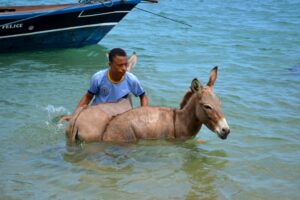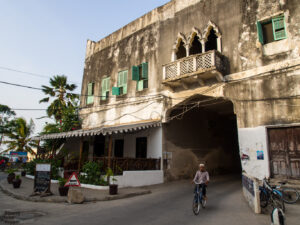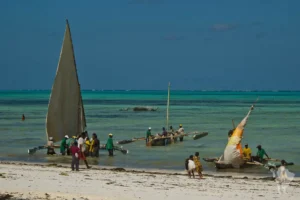I stood in the doorway of my Zanzibar guest house room and gawked at the figure who had knocked on my door and was now standing in the hotel corridor outside.

“I’ve come to Zanzibar,” she said, despite only hours earlier, on a doorstep in Dar Es Salaam, letting me know that her travel plans did not include accompanying me to Zanzibar but would lead her south to Mozambique instead.
Gob-smacked, I was. Gob-smacked – and thrilled. Maybe the tall, surly, scruffy, blonde Dutch woman, who I was gradually getting to know (and growing more and more fond of) as we bumped into each other across multiple locations throughout Kenya and Tanzania, was actually growing fond of me too. She came!
Culture shock!
The first few hours since my arrival on this island, had been intimidating. The “old town” with its narrow streets, (appropriate only for the passage of donkeys, chickens, and humans), it’s bustling markets, its pink stone buildings constructed in ancient Arabic style, its towering mosques, and its people dressed in modest Muslim garb may have been exotic and exciting but their unfamiliarity to an Australian who had just spent years working in Europe had plunged me into culture shock.
Powerfully built fishermen, still wet from hauling fishing nets near the town’s main port, coming up to me and politely asking me if I would fight them in the upcoming Festival of Eid boxing tournament didn’t help with that. I don’t know why they were so keen on beating up mzungus (Swahili for white travelers), but it seemed to be a thing. Hanneke deciding to continue her travels without me hadn’t helped either.

But she was here now! My anxiety and loneliness began to lift. After Hanneke deposited her pack in my room we ventured out into the lanes of the “old town” to explore. Immediately we had to dodge a donkey that was stampeding down a lane with several men in pursuit. We followed the convoy to see what was going on. Soon the lane emptied out onto the main beach where the men were able to capture the frightened, hee-hawing, beast and haul it out onto a wharf. With donkey legs and tail thrashing frantically, the men tipped the beast off the end of the wharf. Was this a local ritual? A sacrifice to the sharks, perhaps? A local late Ramadan tradition? No. The donkey turned and swam back to the shore where the men were waiting, armed with brushes. As it reached the shallows, they pounced on it and gave it a thorough scrubbing. I’m guessing that no Eid celebration is complete without the cleaning of the family mule.
World’s best vegetarian curries
After the donkey show, we settled into a street-side diner where we shared a selection of world-beating and mouth-watering vegetable curries washed down with mango lassis. In between munches and slurps we decided that on the following day we would travel to the Indian Ocean side of the island to explore the fishing villages of Jambiani.
The next morning saw us bravely step into the clouds of blue-black diesel smoke, just down the street, that told us we must be near the bus station. Dozens of fume-belching buses and taxis, just visible in the haze, confirmed our belief that we were at the right place.

We had choices. Cheapest was a daladala where forty people, dozens of chickens, a few dogs and the odd pig would fight over the available eighteen seats. For a few more shillings we could buy an actual seat on a minibus. Private taxi was the most expensive option. Being price-conscious, but not crazy, we chose the minibus, and spend the rest of the morning having our fillings rattled on what was a dodgy but just passable half-tarmac-half-dirt road. After a fifty-kilometre journey through, initially, closed canopy forests, then grassland before running by coastal mangrove swampland (as we approached the eastern shore of the island) we arrived at Jambiani Beach.
Flanked by palm trees the beach stretched on for kilometres only broken up by collections of twin-hull canoes every few hundred metres along the stretch of sand. Behind each cluster of boats was a gathering of simple limestone huts with grass-thatched roofs. The cerulean lagoon that skirted the shore was wave-free courtesy of the coral reef that protected this part of the coast. Bubbling foam caused by ocean waves breaking onto the reef could be seen a few hundred metres off the beach.

Hut, and fish curries, for a few shillings
We inquired at the first village whether we could rent accommodation for a few days and buy food. The village head let us know that, for a few Tanzanian shillings, we could join his people for meals and that for a few shillings more we could stay in one of their huts. Soon we were chowing down on spicey, delicious, fish curry and rice while sitting in a circle on the sand with the local folk. The headman, pointed to an older man sitting cross-legged to his left, and asked us how old we thought he was. After studying the agile, fit-looking guy closely I guessed he might be around fifty. The village head laughed and advised me that the older man was his father… and he was seventy-five.
After hours of chatting around the beach fireplace with the locals, Hanneke and I decided to hit the sack early. The hut provided had a dirt floor, a small wooden table, two chairs and two single straw mattress beds. Basic, but comfortable enough. We both arranged our kikoi sheets (that we had collected on our travels) into bedding, wished each other goodnight, and prepared for sleep. I couldn’t help thinking about how great things were turning out considering how anxious I had been the previous day. The only thing that could make it better would be if my friend was lying next to me instead of across the room.
Suddenly, just as I was dozing off, I felt a body jump into bed next to me. My god, I thought… a dream-come-true!
A voice then whispered… “Don’t get any ideas. There is a mouse in my bed. I’m sleeping with you.”

Travel destination review

Leave a Reply